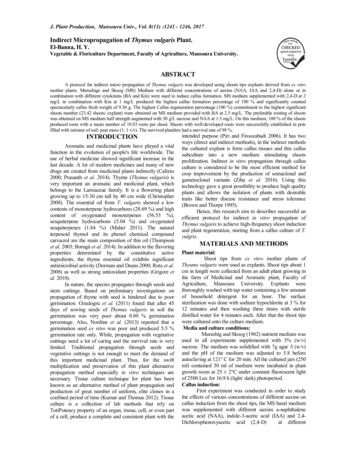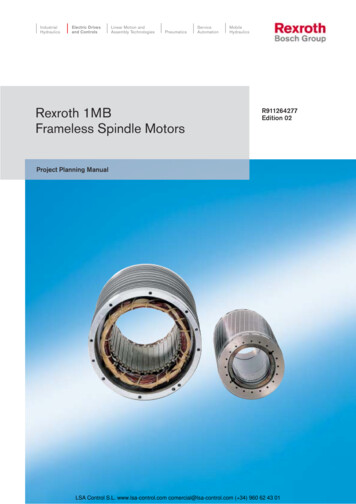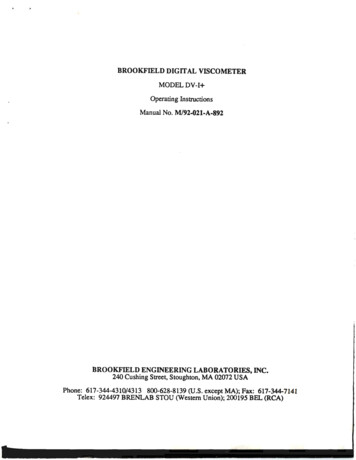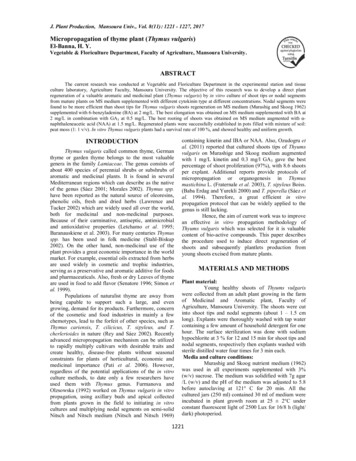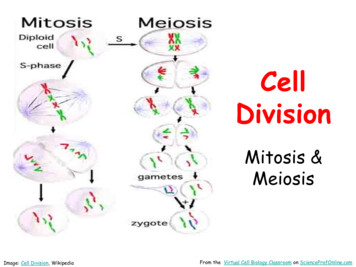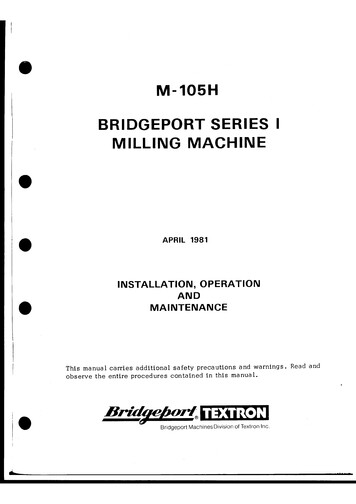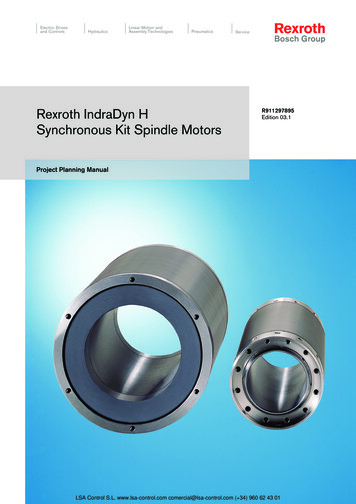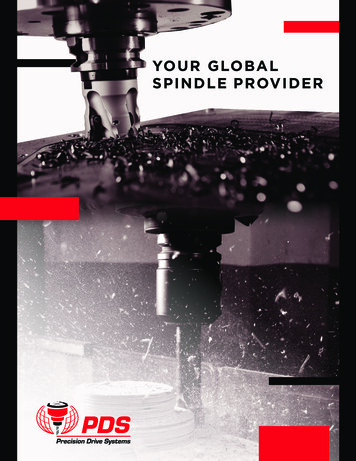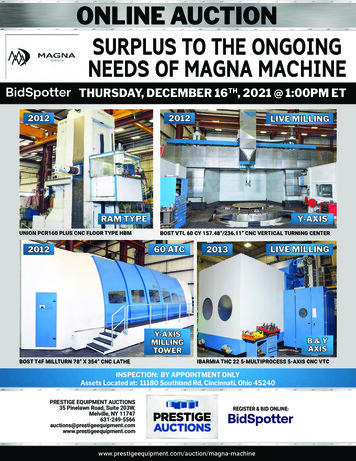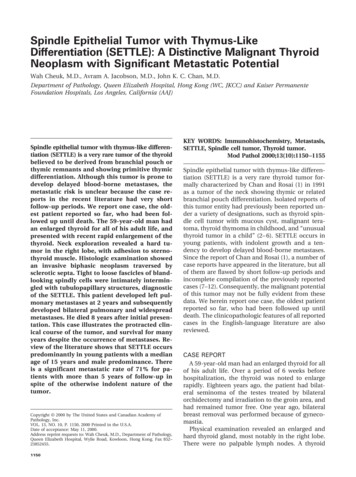
Transcription
Spindle Epithelial Tumor with Thymus-LikeDifferentiation (SETTLE): A Distinctive Malignant ThyroidNeoplasm with Significant Metastatic PotentialWah Cheuk, M.D., Avram A. Jacobson, M.D., John K. C. Chan, M.D.Department of Pathology, Queen Elizabeth Hospital, Hong Kong (WC, JKCC) and Kaiser PermanenteFoundation Hospitals, Los Angeles, California (AAJ)Spindle epithelial tumor with thymus-like differentiation (SETTLE) is a very rare tumor of the thyroidbelieved to be derived from branchial pouch orthymic remnants and showing primitive thymicdifferentiation. Although this tumor is prone todevelop delayed blood-borne metastases, themetastatic risk is unclear because the case reports in the recent literature had very shortfollow-up periods. We report one case, the oldest patient reported so far, who had been followed up until death. The 59-year-old man hadan enlarged thyroid for all of his adult life, andpresented with recent rapid enlargement of thethyroid. Neck exploration revealed a hard tumor in the right lobe, with adhesion to sternothyroid muscle. Histologic examination showedan invasive biphasic neoplasm traversed bysclerotic septa. Tight to loose fascicles of blandlooking spindly cells were intimately intermingled with tubulopapillary structures, diagnosticof the SETTLE. This patient developed left pulmonary metastases at 2 years and subsequentlydeveloped bilateral pulmonary and widespreadmetastases. He died 8 years after initial presentation. This case illustrates the protracted clinical course of the tumor, and survival for manyyears despite the occurrence of metastases. Review of the literature shows that SETTLE occurspredominantly in young patients with a medianage of 15 years and male predominance. Thereis a significant metastatic rate of 71% for patients with more than 5 years of follow-up inspite of the otherwise indolent nature of thetumor.Copyright 2000 by The United States and Canadian Academy ofPathology, Inc.VOL. 13, NO. 10, P. 1150, 2000 Printed in the U.S.A.Date of acceptance: May 11, 2000.Address reprint requests to: Wah Cheuk, M.D., Department of Pathology,Queen Elizabeth Hospital, Wylie Road, Kowloon, Hong Kong. Fax 852–23852455.1150KEY WORDS: Immunohistochemistry, Metastasis,SETTLE, Spindle cell tumor, Thyroid tumor.Mod Pathol 2000;13(10):1150 –1155Spindle epithelial tumor with thymus-like differentiation (SETTLE) is a very rare thyroid tumor formally characterized by Chan and Rosai (1) in 1991as a tumor of the neck showing thymic or relatedbranchial pouch differentiation. Isolated reports ofthis tumor entity had previously been reported under a variety of designations, such as thyroid spindle cell tumor with mucous cyst, malignant teratoma, thyroid thymoma in childhood, and “unusualthyroid tumor in a child” (2– 6). SETTLE occurs inyoung patients, with indolent growth and a tendency to develop delayed blood-borne metastases.Since the report of Chan and Rosai (1), a number ofcase reports have appeared in the literature, but allof them are flawed by short follow-up periods andincomplete compilation of the previously reportedcases (7–12). Consequently, the malignant potentialof this tumor may not be fully evident from thesedata. We herein report one case, the oldest patientreported so far, who had been followed up untildeath. The clinicopathologic features of all reportedcases in the English-language literature are alsoreviewed.CASE REPORTA 59-year-old man had an enlarged thyroid for allof his adult life. Over a period of 6 weeks beforehospitalization, the thyroid was noted to enlargerapidly. Eighteen years ago, the patient had bilateral seminoma of the testes treated by bilateralorchidectomy and irradiation to the groin area, andhad remained tumor free. One year ago, bilateralbreast removal was performed because of gynecomastia.Physical examination revealed an enlarged andhard thyroid gland, most notably in the right lobe.There were no palpable lymph nodes. A thyroid
evidence of nodal metastasis on either side of theneck. Right hemithyroidectomy was carried out.The histologic diagnosis rendered at that time(1970) was medullary thyroid carcinoma, and hadrecently been revised to SETTLE. Two years aftersurgical excision, the patient developed metastasisto the left lung, requiring left upper lobectomy.Subsequently, bilateral pulmonary metastases werefound, and the patient was given chemotherapy.The patient died of disseminated tumor 8 yearsafter initial diagnosis. At autopsy, metastatic deposits were found in the left pleural surfaces, mediastinal lymph nodes, left main bronchus, both lungs,peri-esophageal areas, pancreas, and kidney.FIGURE 1. Thyroid resection specimen. The thyroid parenchyma wasentirely replaced by grayish-tan tumor. A vague lobular pattern wasdiscernible.scan showed a large cold nodule in the right lobe.Systemic investigations did not yield significantfindings.Neck exploration was performed, revealing thatthe right lobe of the thyroid was hard and adherentto the right sternothyroid muscle. There was noPathologic ExaminationGross and histologic appearancesThe thyroid tumor was partially circumscribed,measuring 9 6 3.5 cm. The external surface wasbosselated, and the cut surface showed grayish-tantumor with vague lobulation (Fig. 1).Histologic examination showed an invasive,highly cellular neoplasm traversed by irregular thinand thick sclerotic bands giving rise to multipleFIGURE 2. Low magnification view of tumor. A, the tumor was traversed by irregular fibrous bands giving rise to a lobulated pattern. Note thecomplex tubulopapillary pattern of the glandular component (hematoxylin and eosin stain; original magnification, 6 ). B, thyroid follicles wereentrapped in the invasive fronts of the tumor (hematoxylin and eosin stain; original magnification, 30 ).SETTLE of Thyroid (W. Cheuk et al.)1151
FIGURE 3. Biphasic pattern of tumor. Streaming fascicles of spindlycells merged imperceptibly with tubulopapillary structures (hematoxylinand eosin stain; original magnification, 60 ).vague lobules (Fig. 2). The tumor had a biphasicpattern characterized by merging of cytologicallybland and mitotically inactive spindle cells withtubulopapillary epithelial structures (Fig. 3). Theformer component accounted for approximately40% of the entire tumor.The spindle cells possessed elongated or oval nuclei with delicate chromatin and inconspicuous nucleoli (Fig. 4). Nuclear pleomorphism was minimaland mitotic figures were rare. The scanty to moderate amount of faintly eosinophilic cytoplasm wasill defined. The spindle cells formed tight to loosestreaming fascicles, with focal reticulated patternproduced by intercellular edema. They blended imperceptibly with glands and narrow tubulopapillarystructures that were lined by bland-looking cuboidal to columnar cells. There were some areas whereone of the two components dominated. Lymphocytes were sparse. Focal lymphovascular permeation by tumor cells was present.The metastatic foci in various organs generallyretained the morphology of the original tumor (Fig.5). However, foci of coagulative necrosis were notedin the metastatic tumor in the kidney.1152Modern PathologyFIGURE 4. High magnification view of the tumor. The spindle cellsshowed a streaming pattern and possessed oval vesicular nuclei withminimal nuclear atypia. The glandular structures were lined by blandlooking cuboidal to columnar cells (hematoxylin and eosin stain;original magnification, 120 ).ImmunohistochemistryImmunohistochemical staining was performedusing the VENTANA automated immunostainerwith a labeled streptavidin-biotin peroxidase detection system. The spindle cells as well as the glandular cells showed positive staining for epithelialmarkers (Fig. 6), but negative staining for thyroglobulin, calcitonin, S-100 protein, and actin (Table1). The staining for 34 E12 was the strongest,whereas staining with MNF-116, CAM5.2, and EMAwas more patchy. CD5 was negative. There were noTdT-positive lymphocytes.DISCUSSIONSETTLE, a rare primary tumor of the thyroid, iscomposed of spindle cells of epithelial nature forming fascicles, merging into glandular structures taking the form of tubules, papillae, and cystic spaces.In some cases, cysts or glands lined by mucinous orrespiratory epithelium may be present. Rare casesmay be predominantly monophasic, with spindlecell predominance (10). It has been speculated thatSETTLE represents a neoplasm arising from bran-
FIGURE 6. Immunostaining for pan-cytokeratin in the primarytumor. Diffuse staining was evident in the neoplastic spindly cells (pancytokeratin stain; original magnification, 60 ).FIGURE 5. Metastatic tumor in the lung (hematoxylin and eosinstain; original magnification, 30 ).chial pouch remnants or ectopic thymus, showingpossible differentiation towards embryonic thymus(thymoblastoma) (1). In one case, the SETTLE arosein association with epithelium-lined cysts of possible branchial pouch derivation (8). Nonetheless, sofar convincing proof of thymic differentiation islacking: (1) CD20, a B-cell-associated marker expressed in the epithelial cells in a proportion ofspindle cell (type A) thymomas (13), is consistentlynegative; (2) CD5, a leukocyte marker expressed ina high proportion of thymic carcinomas, is negativein the two cases on which this marker has beenstudied (one previously reported and the currentcase) (14); and (3) TdT immature T lymphocytesthat typically accompany thymomas have not beenfound in this neoplasm. Thus, the histogenesis ofSETTLE remains elusive, and it is even possible thatit represents a primitive thyroid neoplasm (“thyroblastoma”) instead. Notwithstanding the uncertainties on the nature of the tumor, SETTLE is undoubtedly a distinctive tumor type of the thyroid differentfrom other known thyroid neoplasms. When moreis known about the patterns of gene expression inthe thyroid and thymus, analysis of the gene expression patterns in SETTLE using microarray chipscan potentially shed light on the histogenesis of thetumor.In SETTLE, immunohistochemical staining reveals positivity of the spindly tumor cells for epithelial markers, consistent with the ultrastructuralobservation of tonofilaments and desmosomes(7–9, 12). Interestingly, the spindle cells showstrong staining with 34 E12, indicating expressionof high molecular weight cytokeratin as commonlyseen in squamous cells; this feature is also observedin two additional examples of SETTLE that we havestudied (results not shown). Su et al. (9) reportedone case of SETTLE that demonstrated myoepithelial phenotype including immunoreactivity forsmooth muscle actin and ultrastructural evidenceTABLE 1. Immunohistochemical FindingsAntibodySourceDilutionPan-cytokeratin (MNF 116)Low molecular weight cytokeratin (CAM5.2)High molecular weight cytokeratin (34 E12)Epithelial membrane antigen (E29)CD5 (NCL-CD5-4C7)Thyroglobulin (Dako-Tg6)Calcitonin (polyclonal)S-100 protein (polyclonal)Muscle-specific actin (HHF35)Terminal deoxynucleotide transferase (TdT) pattsNovacastraDakopattsDakopattsDakopattsEnzo :10001:31:10Result SETTLE of Thyroid (W. Cheuk et al.)(patchy)(patchy)(diffuse)(patchy)1153
1154Modern PathologyThyroid massPainless neck mass for3 monthsThyromegaly ofundetermineddurationThyroid mass for 2yearsEnlarging thyroid massF/8M/4Long-standing thyroidmass (since adult life)with rapidenlargement for ey et al. (3)Levey (4)Murao et al. (5)Su et al. (9)Weigensberg et al. (6)Kirby et al. (12)Saw et al. (8)Bradford et al. (11)Williams (cited byChan and Rosai) (1)Current reportNA, not available.Not availableM/9Hofman et al. (7)Slow growingasymptomatic thyroidmass for 3 monthsSlow growingasymptomatic thyroidmass for 10 yearsIncidental finding ofneck mass of 10 yearsdurationThyroid mass presentat birth with recentrapid enlargementPainless mass forunknown durationRight neck mass for 4yearsNeck mass for 4monthsTender thyroid massfor 3 weeksM/23M/25F/36Neck mass for 6monthsTracheal compressionPresentationF/14Sex/Age(yr)Harach et al. (2)Chetty et al. (10)Chan et al. (1)AuthorRight lobeNot availableRight lobeRight lower lobeLeft lobeIsthmusRight upper lobeRight lower lobeRight lower lobeRight lower lobeand isthmusRight lower lobeLeft upper lobeDiffusethyromegalyWhole thyroid andperithyroid softtissueRight lobeRight lobeRight upper lobeSite of TumorPartlycircumscribedCircumscribedwith cystic andcalcifiedcomponentNot availableWell circumscribedwith smallnecrotic areaEncapsulated,fleshy massPredominantlyencapsulatedWell circumscribedNoncircumscribedwith ibedEncapsulatedWell apsulatedExtensivelyinfiltrativeGross FeaturesTABLE 2. Clinicopathologic Features of SETTLE of the Thyroid as Reported in the Literature9Right hemithyroidectomyExcisionPartial right lobectomy3.2NATotal thyroidectomyLeft lobectomy, neck dissectionExcision of noduleRight lobectomyRight hemi-thyroidectomy andradiotherapyThyroidectomySubtotal thyroidectomy andchemotherapyRight lobectomy,chemotherapy and cervicallymphadenectomyRight lobectomyTotal thyroidectomySubtotal thyroidectomy andtumor excision; radiationtherapy and chemotherapyRight lobectomyRight lobectomyRight lobectomyInitial Treatment63435322.521234.88.51.8Size(cm)Lung and mediastinum metastasis 25years after initial excisionLung metastasis at 2 years withexcision done; died at 8 years withwidespread tumor dissemination(pleura, lymph node, bronchus,periesophagus, pancreas, kidney)Disease free at 21 monthsDisease free at 46 monthsDisease free at 1 yearNo follow-up informationMetastasis in right kidney at 22 years;alive 2 years after nephrectomy andchemotherapyPulmonary metastasis at 3 years,given chemotherapy; died 6 yearsafter diagnosisDeveloped pulmonary metastasis at 5years and left cervical lymph nodemetastasis at 7 years; died at 7yearsDisease free at 21 monthsDisease free at 3 yearsDisease free at 10 yearsDisease free at 10 monthsNo follow up informationDisease free at 12 monthsDied 14 months later of unrelateddisease with no residual tumorDisease free at 12 yearsFollow-Up
of cytoplasmic filaments with dense bodies. However, this feature is not seen in other cases of SETTLE.From the available data in the literature (17 cases), SETTLE occurs predominantly in children, adolescents, and young adults, with a median age of15 years (range, 4 to 59 years) at presentation (Table2). The male to female ratio is 1.8:1. The patientincluded in this report is the oldest reported so far,but the tumor might have originated in early adulthood because the thyroid mass was present for allof his adult life. In the literature, there are at leastfour other patients who had the thyroid mass noticed for four or more years, attesting to the generally slow growth of the neoplasm. Sometimes rapidenlargement of the lesion is noted in the longstanding thyroid mass.SETTLE pursues an indolent course, but metastasis may not occur until many years after diagnosis(mean, 11.4 years; median, 5 years). The overall rateof metastasis is 33% (5/15) among the reportedcases with follow-up information, but increases to asignificant 71% (5/7) if analysis is made only onpatients who had more than 5 years of follow-up.Among them, two patients developed metastasismore than 20 years after the initial diagnosis. Thepreferential site of metastasis is the lung. Thus,long-term follow-up with particular attention tomonitoring the lungs with imaging studies is advisable. The previous reports with short follow-up periods impart a false picture of “benignity” to thetumor. Another characteristic feature of SETTLE isthat despite development of metastases, long survival for many years is still possible, attesting to theindolence of the tumor, as exemplified by the current case and the case reported by Levey (4).SETTLE must be distinguished from sarcomatoidanaplastic carcinoma because of the very differentprognosis. The latter is characterized clinically byrapid tumor growth and early tumor mortalitywithin 1 year, and histologically by overt nuclearatypia, frequent mitoses, and necrosis. Medullarycarcinoma can have spindle cells and gland-likestructures, and thus may mimic SETTLE, but thefibrovascular septa are much more prominent andthe tumor cells have stippled chromatin and granular cytoplasm. Immunostaining for calcitonin andchromogranin is confirmatory of the diagnosis.SETTLE differs from thymoma in lacking the characteristic jigsaw puzzle-like lobulation, TdTpositive thymocytes, and ultrastructurally interdigitating cell processes. Furthermore, the extensiveglandular pattern of SETTLE is not found in thymoma. Distinction of SETTLE from synovial sarcoma is most difficult, but the spindle cells in synovial sarcoma generally show only patchycytokeratin immunoreactivity and tonofilamentsare not found ultrastructurally.In conclusion, this report documents the complete follow-up of an example of SETTLE, and provides the most comprehensive review on the behavioral features of this tumor, putting its metastaticpotential into proper perspective.REFERENCES1. Chan JK, Rosai J. Tumors of the neck showing thymic orrelated branchial pouch differentiation: a unifying concept.Hum Pathol 1991;22:349 – 67.2. Harach HR, Saravia Day E, Franssila KO. Thyroid spindle-celltumor with mucous cysts. An intrathyroid thymoma?Am J Surg Pathol 1985;9:525–30.3. Kingsley DPE, Elton A, Bennett MH. Malignant teratoma ofthe thyroid: case report and a review of the literature. Br JCancer 1968;22:7–11.4. Levey M. An unusual thyroid tumor in a child. Laryngoscope1976;86:1864 – 8.5. Murao T, Nakanishi M, Toda K, Honishi H. Malignant teratoma of the thyroid gland in an adolescent female. ActaPathol Jpn 1979;29:109 –17.6. Weigensberg C, Dalsley H, Asa SL, Bedard YC, Mullen JBM.Thyroid thymoma in childhood. Endocr Pathol 1990;1:123–7.7. Hofman P, Mainguene C, Michiels JF, Pages A, Thyss A.Thyroid spindle epithelial tumor with thymus-like differentiation (the “SETTLE” tumor). An immunohistochemical andelectron microscopic study. Eur Arch Otorhinolaryngol 1995;252:316 –20.8. Saw D, Wu D, Chess Q, Shemen L. Spindle epithelial tumorwith thymus-like element (SETTLE), a primary thyroid tumor. Int J Surg Pathol 1997;4:169 –74.9. Su L, Beals T, Bernacki EG, Giordano TJ. Spindle epithelialtumor with thymus-like differentiation: a case report withcytologic, histologic, immunohistologic, and ultrastructuralfindings. Mod Pathol 1997;10:510 – 4.10. Chetty R, Goetsch S, Nayler S, Cooper K. Spindle epithelialtumour with thymus-like element (SETTLE): the predominantly monophasic variant. Histopathology 1998;33:71– 4.11. Bradford CR, Devaney KO, Lee JI. Spindle epithelial tumorwith thymus-like differentiation: a case report and review ofthe literature. Otolaryngol Head Neck Surg 1999;120:603– 6.12. Kirby PA, Ellison WA, Thomas PA. Spindle epithelial tumorwith thymus-like differentiation (SETTLE) of the thyroidwith prominent mitotic activity and focal necrosis. Am J SurgPathol 1999;23:712– 6.13. Chilosi M, Castelli P, Martignoni G, Pizzolo G, Montresor E,Facchetti F, et al. Neoplastic epithelial cells in a subset ofhuman thymomas express the B cell-associated CD20 antigen. Am J Surg Pathol 1992;16:988 –97.14. Dorfman DM, Shahsafaei A, Chan JK. Thymic carcinomas,but not thymomas and carcinomas of other sites, show CD5immunoreactivity. Am J Surg Pathol 1997;21:936 – 40.SETTLE of Thyroid (W. Cheuk et al.)1155
pression patterns in SETTLE using microarray chips can potentially shed light on the histogenesis of the tumor. In SETTLE, immunohistochemical staining re-veals positivity of the spindly tumor cells for epi-thelial markers, consistent with the ultrastructural observation of tonofilaments and desmosomes (7-9, 12). Interestingly, the spindle .
